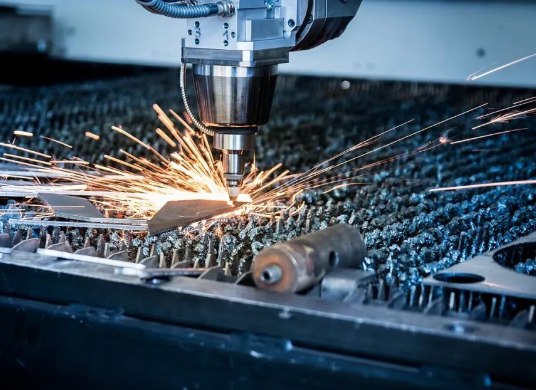
Laser additive manufacturing (AM) technology, with its advantages of high manufacturing accuracy, strong flexibility, and high degree of automation, is widely used in the manufacturing of key components in fields such as automotive, medical, aerospace, etc. (such as rocket fuel nozzles, satellite antenna brackets, human implants, etc.). This technology can greatly improve the combination performance of printed parts through integrated manufacturing of material structure and performance. At present, laser additive manufacturing technology generally adopts a focused Gaussian beam with a high center and low edge energy distribution. However, it often generates high thermal gradients in the melt, leading to the subsequent formation of pores and coarse grains. Beam shaping technology is a new method to solve this problem, which improves printing efficiency and quality by adjusting the distribution of laser beam energy.
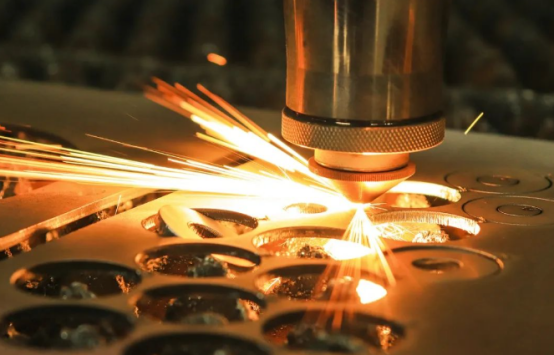
Compared with traditional subtraction and equivalent manufacturing, metal additive manufacturing technology has advantages such as short manufacturing cycle time, high processing accuracy, high material utilization rate, and good overall performance of parts. Therefore, metal additive manufacturing technology is widely used in industries such as aerospace, weapons and equipment, nuclear power, biopharmaceuticals, and automobiles. Based on the principle of discrete stacking, metal additive manufacturing utilizes an energy source (such as laser, arc, or electron beam) to melt the powder or wire, and then stacks them layer by layer to manufacture the target component. This technology has significant advantages in producing small batches, complex structures, or personalized parts. Materials that cannot be or are difficult to process using traditional techniques are also suitable for preparation using additive manufacturing methods. Due to the above advantages, additive manufacturing technology has attracted widespread attention from scholars both domestically and internationally. In the past few decades, additive manufacturing technology has made rapid progress. Due to the automation and flexibility of laser additive manufacturing equipment, as well as the comprehensive advantages of high laser energy density and high processing accuracy, laser additive manufacturing technology has developed the fastest among the three metal additive manufacturing technologies mentioned above.
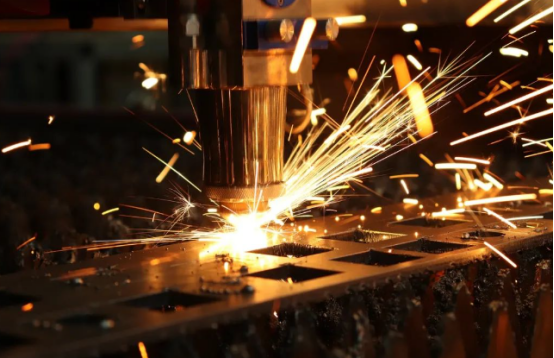
Laser metal additive manufacturing technology can be further divided into LPBF and DED. Figure 1 shows a typical schematic diagram of LPBF and DED processes. The LPBF process, also known as Selective Laser Melting (SLM), can manufacture complex metal components by scanning high-energy laser beams along a fixed path on the surface of a powder bed. Then, the powder melts and solidifies layer by layer. The DED process mainly includes two printing processes: laser melting deposition and laser wire feeding additive manufacturing. Both of these technologies can directly manufacture and repair metal parts by synchronously feeding metal powder or wire. Compared to LPBF, DED has higher productivity and larger manufacturing area. In addition, this method can also conveniently prepare composite materials and functionally graded materials. However, the surface quality of parts printed by DED is always poor, and subsequent processing is needed to improve the dimensional accuracy of the target component.
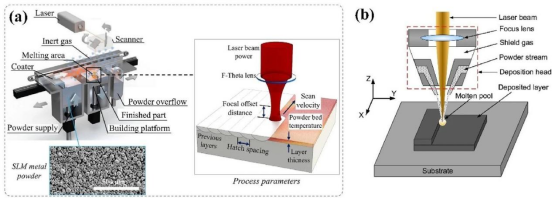
In the current laser additive manufacturing process, the focused Gaussian beam is usually the energy source. However, due to its unique energy distribution (high center, low edge), it is likely to cause high thermal gradients and instability of the melt pool. Resulting in poor forming quality of printed parts. In addition, if the center temperature of the molten pool is too high, it will cause the low melting point metal elements to vaporize, further exacerbating the instability of the LBPF process. Therefore, with an increase in porosity, the mechanical properties and fatigue life of printed parts are significantly reduced. The uneven energy distribution of Gaussian beams also leads to low laser energy utilization efficiency and excessive energy waste. In order to achieve better printing quality, scholars have begun to explore compensating for the defects of Gaussian beams by modifying process parameters such as laser power, scanning speed, powder layer thickness, and scanning strategy, in order to control the possibility of energy input. Due to the very narrow processing window of this method, fixed physical limitations limit the possibility of further optimization. For example, increasing laser power and scanning speed can achieve high manufacturing efficiency, but often comes at the cost of sacrificing printing quality. In recent years, changing the laser energy distribution through beam shaping strategies can significantly improve manufacturing efficiency and printing quality, which may become the future development direction of laser additive manufacturing technology. Beam shaping technology generally refers to adjusting the wavefront distribution of the input beam to obtain the desired intensity distribution and propagation characteristics. The application of beam shaping technology in metal additive manufacturing technology is shown in Figure 2.
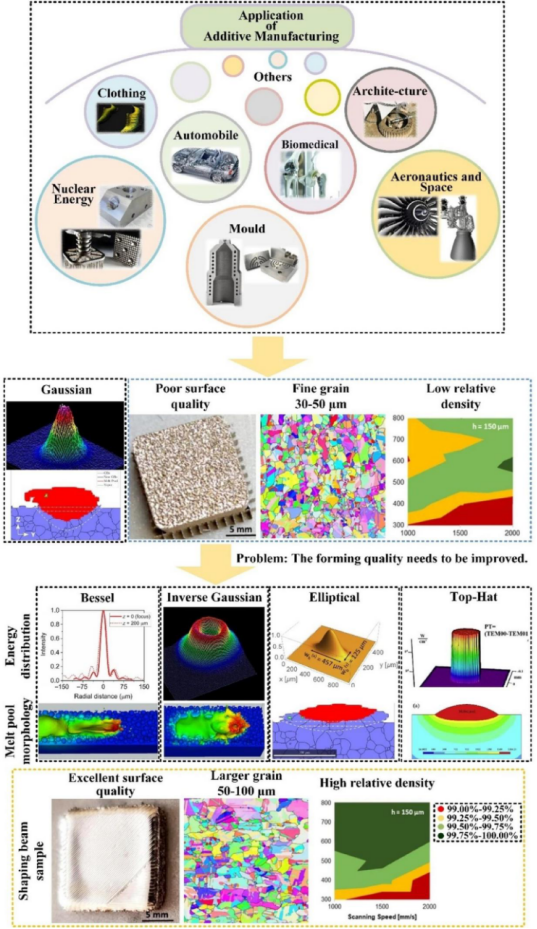
Application of beam shaping technology in laser additive manufacturing
The shortcomings of traditional Gaussian beam printing
In metal laser additive manufacturing technology, the energy distribution of the laser beam has a significant impact on the quality of printed parts. Although Gaussian beams have been widely used in metal laser additive manufacturing equipment, they suffer from serious drawbacks such as unstable printing quality, low energy utilization, and narrow process windows in the additive manufacturing process. Among them, the melting process of the powder and the dynamics of the molten pool during the metal laser additive process are closely related to the thickness of the powder layer. Due to the presence of powder splashing and erosion zones, the actual thickness of the powder layer is higher than the theoretical expectation. Secondly, the steam column caused the main backward jet splashes. The metal vapor collides with the rear wall to form splashes, which are sprayed along the front wall perpendicular to the concave area of the molten pool (as shown in Figure 3). Due to the complex interaction between the laser beam and splashes, the ejected splashes can seriously affect the printing quality of subsequent powder layers. In addition, the formation of keyholes in the melt pool also seriously affects the quality of printed parts. The internal pores of the printed piece are mainly caused by unstable locking holes.
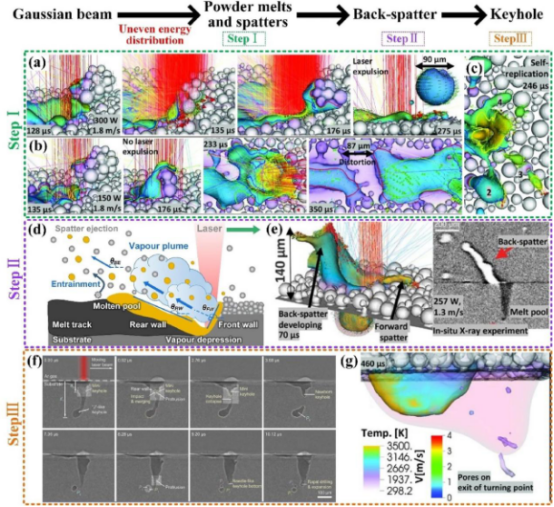
The formation mechanism of defects in beam shaping technology
Beam shaping technology can achieve performance improvement in multiple dimensions simultaneously, which is different from Gaussian beams that improve performance in one dimension at the cost of sacrificing other dimensions. Beam shaping technology can accurately adjust the temperature distribution and flow characteristics of the melt pool. By controlling the distribution of laser energy, a relatively stable molten pool with a small temperature gradient is obtained. Appropriate laser energy distribution is beneficial for suppressing porosity and sputtering defects, and improving the quality of laser printing on metal parts. It can achieve various improvements in production efficiency and powder utilization. At the same time, beam shaping technology provides us with more processing strategies, greatly liberating the freedom of process design, which is a revolutionary progress in laser additive manufacturing technology.
Post time: Feb-28-2024
















